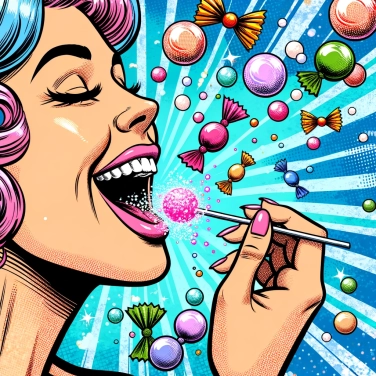Fizzy candies typically contain citric acid and sodium bicarbonate. When these two substances come into contact with saliva, they react to produce carbon dioxide, creating bubbles that cause a tingling sensation on the tongue.

The secret of fizzy candies lies in the chemical duo of citric acid and sodium bicarbonate. When these substances encounter the moisture in your mouth, they react with each other and quickly release carbon dioxide (CO₂). This CO₂ is released in the form of tiny gas bubbles, bursting directly on your tongue. And there you go, it fizzes! It is this effervescent carbon dioxide that causes the famous tingling sensation. The more moisture (like saliva) comes into contact with these substances, the faster the reaction accelerates, further increasing the crackling and tingling sensation that so delights your taste buds.
As soon as the popping candies come into contact with the tongue, they release carbon dioxide, forming lots of tiny bubbles that burst directly on your tongue. These micro-explosions stimulate specific cells called sensory receptors. Among them, the most sensitive here are the touch and pain receptors, particularly the nociceptors. They detect these mini gas explosions as an unusual signal, instantly triggering a feeling of tingling and a funny buzzing sensation. These sensory receptors immediately send the information to the brain, alerting it that a small unusual agitation is occurring. That’s why you clearly feel that funny sparkling sensation on your tongue.
Saliva plays a key role in the more or less intense sensation of fizzy candies. The wetter your mouth is, the more easily the candy releases carbon dioxide, causing those famous little tingling bubbles. Your saliva acts as an accelerator, amplifying the chemical reaction between the ingredients of the candy, which increases the tingling sensation felt on your tongue. Conversely, a dry mouth limits this reaction, making the experience significantly less spectacular and fizzy.
As the popping candy melts on your tongue, specific nerve endings called nociceptors come into play. These sensory receptors detect the signals produced by the small gas explosions caused by the chemical reaction. This information is then sent in the form of electrical impulses to the brain, and more specifically to an area called the somatosensory cortex. It is this region of the brain that interprets these impulses as a slight tingling or crackling sensation, which explains why you perceive that popping sensation when you enjoy those famous candies.
The temperature of your saliva can influence the speed at which gas bubbles are released in your mouth; thus, warmer saliva or a warm oral environment slightly enhances the sparkling sensation.
The tingling sensation from fizzy candies comes from a chemical reaction between citric acid and baking soda, producing bubbles of carbon dioxide that stimulate the sensory receptors on the tongue.
When you bite or chew the fizzy candies, you release more carbon dioxide at once, thereby immediately increasing the intensity of the tingling sensation.
Your language has sensory receptors sensitive to pressure changes and gas bubbles, which explains why each person perceives the intensity of the tingling associated with fizzy candies differently.
By closing the mouth, we allow the carbon dioxide released by the chemical reaction in the saliva to concentrate, temporarily increasing the intensity of the tingling sensation.
The main ingredient responsible for the sparkling effect is a mixture of citric, malic, or tartaric acid combined with baking soda or another similar alkaline compound. When in contact with saliva, a chemical reaction produces gaseous carbon dioxide, causing the tingling sensation.
Yes, a dry tongue will reduce or prevent the chemical reaction, as saliva is necessary to trigger the reaction that releases the gas causing the sparkling sensation.
The sensation of cold comes from the endothermic process (absorbing energy) caused by the chemical reaction between organic acids and baking soda. This process slightly absorbs the surrounding heat, which is why there is a cool sensation on the tongue.
No, in the quantities typically consumed, popping candies do not pose a danger. The tingling sensation is simply due to the release of gas (carbon dioxide), which temporarily stimulates the taste receptors on the tongue in a safe manner.

No one has answered this quiz yet, be the first!' :-)
Question 1/5
What is the main ingredient that causes the tingling of fizzy candies on the tongue?